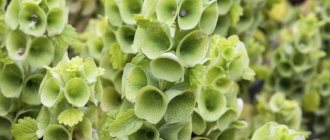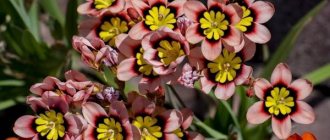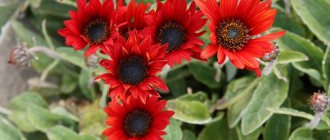An attractive, aromatic plant can be grown by direct sowing of seeds in the ground or by preparing seedlings. Both planting methods have their pros and cons. The seedless method is easier for the gardener and less traumatic for a delicate plant.
Growing conditions:
Plant Levka in sunny areas - it loves the heat.
The flower can be content with poor soil, but it must be sufficiently well drained.
Matthiola is a perennial plant, but in some years it disappears. Therefore, most often matthiolas that bloom in summer are grown as annuals, and those that bloom in spring are grown as biennials.
Timing for sowing matthiola for seedlings and open ground
The time for sowing plants for seedlings depends on the climate of the area where the garden is located and the method of cultivation. Levkoy loves coolness and good lighting. If seedlings are driven out in heated greenhouses, conservatories, and insulated balconies, sowing can be done 2-3 weeks earlier than usual.
Approximate dates for sowing matthiola in different regions of the country:
| Region | Landing dates |
| middle zone and Moscow region | from mid to late March |
| regions of the Urals and Siberia | April |
| south | from late February to mid March |
Matthiola seedlings are planted in May - June, already with buds.
Direct sowing of the flower with seeds in the ground is carried out in the first half of May. Plant seedlings may suffer from frost, so the bed is covered with film. Winter sowing is also practiced, in October – November.
The seedless method of growing matthiola is suitable for the southern regions, where there are long, warm autumns and mild winters.
When to plant according to the lunar calendar 2022
| Month | Better days | Month | Better days |
| January | 23-27 | April | 3-7, 12-15, 21, 22 |
| February | 4-14, 17-23 | May | 2-5, 12-14, 18-25 |
| March | 3-16, 20-21 | June | 1-3, 6-13 |
In 2022, unfavorable days fall on the following dates:
- January — 2, 3, 17, 18
- February — 1, 2, 16, 28
- March — 1, 2, 18, 27, 28
- April — 1, 2, 16, 23
- May — 1, 16, 30
- June -14, 18, 29
- July — 13, 14, 28, 29
- August — 11, 12, 27-28
- September: 9-10, 26, 27
- October: 9, 10, 25, 26
- November: 1, 2, 7-9, 24, 25, 28, 29
- December: 7-9, 23-25
@delianasgarden. Instagram
@loukes67, Instagram
Kinds
There are 3 types grown in our country:
- Levkoy gray or gray (lat. Matthiola incana) - grown in the Middle Zone, Moscow region and to the south.
- Fragrant leftover (lat. Matthiola fragrans) - grown in the Voronezh, Rostov regions and further south.
- Levkoy Tatar (lat. Matthiola tatarica).
It is rare to see the long-petaled gillyflower (Matthiola longipetala), which smells great but is not particularly ornamental.
The natural species most often grown in gardens is the grey-headed left-wing, its cultivation will be discussed in this article. About 20 million of these flowers are sold annually on Dutch stock exchanges.
Levkoy grey, often called matthiola grey, is a representative of the natural flora of the Mediterranean and Canary Islands. Its natural habitats are also found in Europe, Asia, and Africa. In our conditions, it grows to about 60 centimeters and has straight shoots.
Levy flowers appear in June and persist until July, forming magnificent inflorescences with an unusual, very strong, characteristic odor, a bit like the aroma of the spice cloves. For this smell, which intensifies at night, it is also called “night violet”. The flower is large and expressive. The stems and leaves are covered with a layer of hairs, and numerous branches form on the stem.
Seed treatment, soil preparation
Hardening and germination of seeds will help speed up the germination of matthiola and strengthen the health of future plants.
Levkoy seed material is placed in a fabric bag and soaked in moisture. You need to make sure that the seeds do not float in the water, but also do not dry out. First, the seeds are kept warm (8-12 hours), then they are put in the vegetable section of the refrigerator for 3-5 days.
In addition to hardening, Levka can be treated with any plant growth stimulator: Energen, Epin, Zircon. Some gardeners use folk remedies: succinic acid solution, aloe juice.
If the seeds were collected from your own plants, you need to pickle them in a pink solution of potassium permanganate for half an hour or soak them in a solution of Fitosporin. This treatment will destroy fungal spores from the seed material.
Light soil with a significant admixture of sand is suitable for matthiola. You can buy soil “for succulents” in the store, or make your own substrate. To prepare the correct soil mixture you will need:
- 2 parts of turf soil (good soil is collected in the forest, under a layer of leaf litter);
- 1 part mature vegetable compost;
- 2 parts coarse sand or perlite.
It is recommended to treat all components of the mixture with steam, boiling water or fry in the oven to destroy infections.
You can add 1 cup of wood ash per 5 liters to the prepared soil to eliminate excess acidity and complex granular fertilizer.
Flowering period
Each variety of Matthiola blooms differently, for example:
- Double-horned matthiola blooms from June to August. During this period, the inflorescences resemble quatrefoils. The petals are purple or light pink and have an intense aroma.
- Grey-haired gillyflower has a woody stem on which double inflorescences of pink, blue, white and yellow flowers flutter in corollas. You can also find annuals with dark purple and lilac flowers.
- Sweet gillyflower blooms in early summer and has simple yellow-brown buds that open after sunset.
Plant care
To obtain early flowering, matthiola is grown through seedlings. Choose a place for the flower that is well-lit, with fertile and well-drained soil.
Watering
Moderate – 2-3 times a week, regular, in small portions. The root system of gillyflower is not deep. If there is a lack of moisture, few buds are formed on the plant.
Top dressing
When growing gillyflower, it is not recommended to use manure and large amounts of nitrogen fertilizers. When preparing the beds, emphasis is placed on phosphorus (superphosphate) and potassium (potassium sulfate), ash, and vermicompost.
Flowering plants are fed with complex mineral fertilizer (Agricola, Pollen, Fertika).
@edwood09, Instagram
Transfer
The seedlings are transplanted into the flower bed using the transshipment method, without destroying the earthen coma.
Wintering
It is grown as an annual plant.
Varieties
The wealth of forms and varieties of gray-haired left-handed grass is varied. When purchasing seeds, you need to pay attention to the flowering period. You can choose varieties with double or simple flowers, tall or short. Low varieties (Elegance and Cinderella series) can be used for growing in all types of containers. Varieties also differ in flowering time; flowers can develop on shoots from June to the end of August.
Varieties are divided into 2 groups:
- The first group includes varieties that produce branched shoots, that is, multi-stemmed. They are great for flower beds.
- The second group includes varieties with one shoot, tall and short. Such shoots end in inflorescences on which a double or simple flower is located.
The double flower of the gillyflower is sterile, since its stamens and pistil have turned into additional petals; it does not produce seeds. Therefore, seeds are collected only from simple flowers. From such seeds, plants with double and simple flowers develop, approximately 50% each (for some varieties this proportion is different). Flowers can be white, pink, yellowish.
Depending on the variety, plants may vary in color, plant shape, and flower shape. Height can fluctuate in the range of 60-70 centimeters. There are dwarf varieties that reach only 20 centimeters. The leaves are mostly lanceolate, slightly pubescent and have a rounded tip.
The group that unites single-stem varieties of gillyflower includes Excelsior. Examples of varieties:
- "Rawa" Rawa is a cherry-colored variety.
- “Bara” Bara is a variety with double, beige flowers.
- "Opal" Opal - white flowers.
- "Antar" Antar is a variety with double lilac-pink flowers.
- "Weiss" Weiss - double, white flowers.
- "Kanu" Kanu - red flowers.
- "Yucca" Juka is an interesting plum-colored variety.
- “Khash” Hasz is a variety with bright pink flowers.
- "Hena" Hena - light yellow flowers.
Another group of single-stem varieties is Varsovia, which includes:
- "Bona" Bona - with double, bright yellow flowers.
- "Yaga" Jaga - pink flower.
- "Olga" Olga - plum-colored flowers.
- "Mera" Mera - has white flowers.
Multi-stemmed varieties of gillyflower include:
- The “Dresden” group of varieties - plants reach 60 centimeters in height, are highly branched, compact, and capable of repeated flowering.
- “Bomb” group – characterized by high height and colorful variations.
- The Erfurt group are small plants that look good on the balcony.
The duration of growing gillyflower depends on the temperature and length of the day:
- In order for the plant to reach the desired height and number of leaves, it needs a temperature between 8° and 23° Celsius.
- Lower temperatures affect the growth of plants, which become shorter, have fewer leaves, and also affect the length of the inflorescences.
Therefore, during the growth period it is necessary to ensure the correct temperature. This can be done in greenhouses where they grow gillyflower for sale for bouquets.
The most interesting varieties of gillyflower with double flowers:
- white: Opal, Mera, Maribell White, Regal White, Noble White;
- cream: Centum Cream, Mid Cheerful Yellow, Noble Cream;
- pink: Khash, Yaga, Maribell Rose, Maribell Dark Rose;
- purple: Kanu, Mawa, Hala, Opera Deborah, Jordyn Lavender, Aida Blue;
- burgundy: Kama, Maribell Red, Opera Francesca, Jordyn Red.
Pests and diseases
Mattiola may suffer from rot, blackleg, clubroot. For prevention and treatment, the following actions are used:
- pickle the substrate for seedlings with potassium permanganate or foundationol;
- loosen the soil after watering;
- water only with warm water;
- Do not plant after plants from the Cruciferous family.
Matthiola can be affected by aphids and cruciferous flea beetles. Insects are gotten rid of using Iskra and Aktara.
Possible problems
Matthiola cannot be called a whimsical plant, but an inexperienced gardener may encounter the following difficulties when growing it:
| Problem | Possible reasons |
| seeds do not germinate well | no stratification, deep embedding, low soil moisture |
| shoots are weak and stretch | little light, soil poor in nutrients |
| weak flowering | lack of moisture |
General description with photo
Matthiola is a herbaceous flowering crop, in the genus of which there are annual and perennial species. The height of the shoots can reach 1 m, but there are also low-growing varieties. The stems are branched, rigid, quickly woody, many varieties are densely pubescent with soft felt, but there are also varieties with bare shoots. The bushes are densely leafy, the foliage is soft, lanceolate-shaped, pubescent, the bulk of it grows in the lower part of the branches.
Flowering is early and long-lasting, beginning in late spring and or June, but there are also autumn-blooming varieties. Racemose loose inflorescences are collected from small buds of white, pink, beige, yellow, purple; dark-colored varieties in burgundy and purple tones are less common. During the day they are usually closed and only in the evening they open their petals, emitting a sweetish spicy aroma. Matthiola is pollinated by nocturnal insects. The fruit is a small flattened pod, from which many small round seeds of a dark brown, almost black color spill out.
Mattiola easily tolerates transplantation and does not suffer from short-term frosts.
Matthiola bicorne, evening scent, bicorne mix
When to plant seedlings
Mattiola two-horned or night violet is one of the most popular flowers among summer residents. With its extraordinary aroma, it invites you to the gazebo for an evening cup of tea or to sit on the porch, look at the stars, listen to cricket songs. When to plant seeds for seedlings?
To get early flowering, seeds are planted on seedlings in March. The best germination will be on loamy, sandy soils. But, in principle, the plant is not whimsical; it will grow anywhere with regular feeding. Strongly grown plants do not tolerate transplantation well, so many people prefer to sow seeds directly into the ground.
When growing seedlings, adhere to the basic rules:
- compliance with the temperature regime (+12 +15° C), when seedlings appear, the temperature drops to +10° C;
- moderate watering;
- prevention of blackleg disease;
- when 2 true leaves appear, dive and transplant into single containers;
- The seedlings are hardened for 2 weeks;
- a plant with five leaves is transplanted into the ground.
For planting seedlings, choose sunny areas; in the shade, the night violet stretches out strongly and lies down. The chosen place should be dry, without stagnant water.
Planting gillyflower with seeds - step-by-step instructions
Seed preparation
First of all, you need to check which seeds are suitable for sowing, and which are empty and need to be thrown away. To do this, prepare a solution from a glass of water and 1 teaspoon of salt (heaped), pour it into a wide container, pour the seeds into it and mix. After 20-30 minutes, discard the seeds that have floated up, and rinse those that have sunk to the bottom under running water.
You will be interested to know: A simple method of sowing annual aster for seedlings step by step with photos
To speed up germination, seeds are wrapped in damp gauze, sprayed with warm water, placed in a plastic bag and kept at room temperature for a day. Then the seed in damp gauze is placed in the refrigerator for several days. Seeds that have passed stratification are ready for sowing.
It is important! Seed material treated by the manufacturer does not need to be soaked. It is already ready for sowing.
Preparing soil and containers
To sow matthiola, you can use soil for seedlings or for flowers from the store. The soil is mixed independently from turf soil and sand (3:1). The prepared soil will need to be disinfected a few days before planting with a strong solution of potassium permanganate or calcined in the oven.
You can use a box, container or disposable cups as seedling containers. If sowing is carried out in a common container, then in the future the seedlings of the gillyflower will need to be picked.
Be sure to wash the seedling containers that were used last year with a solution of potassium permanganate.
Sowing matthiola seeds
The boxes are filled with moist soil, in which grooves are made 0.5 cm deep. Seeds are sparsely laid out in them, sprinkled with a small layer of sand or soil, sprayed with warm water and covered with film on top. Before emergence, crops should be kept in a warm, dark place. You can place the box on or under the battery.
If you sow matthiola seeds in disposable cups, place 2-4 seeds at a time, since even after discarding, not all seeds may sprout. When the seedlings grow up, you will need to choose the strongest one and cut off the rest near the ground. Of course, if there is little seed material, then it is better to plant one seed in each glass.
Shoots may appear in 4-15 days. All this time, the crops are ventilated every day, and the soil, if necessary, is moistened with warm water from a sprayer.
You will be interested to know: Growing viola from seeds: when to plant, planting and care, types and varieties
Watch a video about sowing gillyflower seeds for seedlings and further caring for the seedlings.
Use in landscape design
Mattiola is considered one of the few plants that are bred not for their external characteristics, but for their wonderful aroma. Decorative terry varieties are used to decorate flower beds and create various color compositions. A cut plant can maintain its original appearance for a week. Matthiola is usually grown near benches and windows of houses, as well as in other places intended for recreation. Excellent neighbors for culture are rosemary, lavender, mignonette, thyme, and cornflower.
Matthiola is a beautiful plant with a pleasant, memorable aroma. It is this feature that has made the culture so popular. It’s hard to notice because it’s not always planted in visible places, but you can’t help but smell it.











